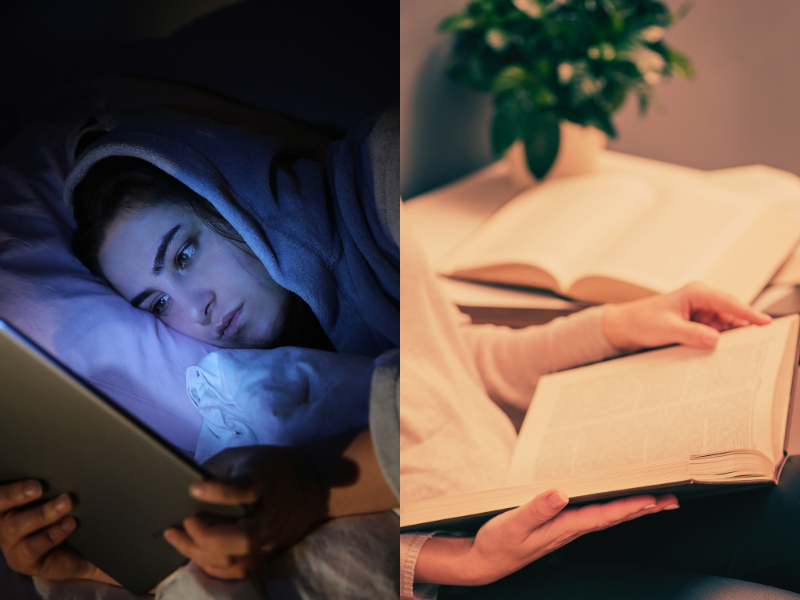Fixing Your Light Exposure for Better Energy, Sleep & Metabolism
You’re Doing Everything Right—So Why Don’t You Feel Better?
You eat well, exercise, and prioritise sleep, yet something still feels off. If you’re struggling with low energy, poor sleep, or stubborn weight, fixing your light exposure could be the missing piece in your health journey.
Most people focus on diet and exercise, but few consider the power of light exposure in regulating metabolism, hormones, and energy. Modern lifestyles have disconnected us from the natural light cycles our bodies depend on, and the effects are more profound than you might think.
How Circadian Rhythms Influence Your Health
Your circadian rhythm is your body’s internal clock, designed to keep everything running smoothly. It regulates your sleep-wake cycle, metabolism, hormone production, digestion, and even mental clarity. This clock is primarily set by light exposure—not just any light, but the right light at the right time.
When your circadian rhythm is in sync, your body operates efficiently. When it’s out of sync—thanks to artificial light, late-night screens, or lack of morning sunlight—your metabolism, hormones, and energy levels suffer.

My Personal Experience with Light Exposure
I can personally attest to how transformative light exposure can be. In recent years, I started focusing on aligning my light exposure with natural rhythms, and it’s been one of the missing pieces for me. It helped me regulate my hormones, stabilise my blood sugar balance, and bring much-needed consistency to my sleep-wake cycles. As a result, my energy levels have improved, and I no longer feel drained by midday.
For example, by getting morning sunlight within the first 30–60 minutes of my day, I noticed a significant boost in my energy and mood. I felt more clear-headed and less reliant on caffeine. I also became more in tune with my hunger cues, which made it easier to maintain a balanced diet.
One of the biggest changes I made was switching to blue light-blocking glasses after sunset when using screens. Along with this, I changed all the lightbulbs in our house from LEDs to blue-blocking bulbs. This made a huge difference, not only for my sleep but also for my children. They used to complain about struggling to fall asleep, but after making these changes, they now fall asleep within 5-10 minutes, almost overnight. We’ve also made it a family habit to go for a walk straight after breakfast every morning, which helps us all align our circadian rhythms and start the day with energy.
The Link Between Light Exposure and Metabolism
Your metabolism isn’t just influenced by diet and exercise—it’s deeply tied to your circadian rhythm, which is regulated by light exposure. The type, timing, and intensity of light you receive throughout the day play a crucial role in hormone production, energy levels, appetite regulation, and fat storage.
Morning Light: Setting the Metabolic Clock
The best way to support your metabolism is to get morning sunlight as soon as possible after waking. Stepping outside within the first 30–60 minutes of the day (even if it’s cloudy) triggers:
✅ Cortisol Release – Helps wake you up and regulates blood sugar.
✅ Melatonin Suppression – Stops sleep hormone production, so it can build up later.
✅ Dopamine & Serotonin Production – Supports mood, motivation, and the conversion of serotonin into melatonin for better sleep.
✅ Insulin Sensitivity – Helps your body process carbohydrates more efficiently, reducing the risk of blood sugar crashes and cravings.
🔹 Practical Tip: Aim for at least 10 minutes of outdoor light exposure in the morning (30 minutes if it’s overcast). Avoid sunglasses during this time to allow full-spectrum light to reach your eyes.
Midday Light: Energy and Vitamin D (or Not!)
Midday light, particularly around solar noon, contains the highest concentration of blue and UV light, which boosts energy, metabolism, and vitamin D production—but only when UVB rays are present.
• In summer, UVB rays allow your body to synthesise vitamin D, which is crucial for mitochondrial function, immune health, and metabolic regulation – the vitamin D from careful sun exposure can be stored in the body for use in winter (just be cautious not to burn, and increase exposure gradually).
• In winter (above 35° latitude, including the UK), UVB rays don’t reach the ground, meaning you cannot produce vitamin D from sunlight. This is why many people feel more sluggish in winter.
Even when vitamin D isn’t available, midday light still has metabolic benefits:
✅ Enhances alertness and productivity via blue light exposure.
✅ Boosts thyroid function, which regulates metabolic rate.
✅ Regulates hunger hormones, reducing overeating later in the day.
🔹 Practical Tip: If possible, take a short outdoor break around midday, even in winter. On cold days, try sitting near a window to get some natural light, but remember that glass blocks UVB rays, so it won’t help with vitamin D.
Evening Light: The Metabolic Downshift
As the sun sets, your body naturally shifts into rest-and-digest mode, preparing for sleep, repair, and fat metabolism. But exposure to artificial blue light (from screens, LEDs, and indoor lighting) after sunset can:
⚠️ Disrupt melatonin production, making it harder to fall asleep.
⚠️ Reduce insulin sensitivity, increasing the likelihood of weight gain and blood sugar imbalances.
⚠️ Trigger late-night cravings by disrupting leptin and ghrelin (hunger hormones).
🔹 Practical Tip:
• After sunset, dim overhead lights and use warmer tones (like red or amber).
• Avoid screens for at least an hour before bed, or use blue light-blocking glasses like these (nightfall glasses with the red/orange tint are the most effective – feel free to use discount code RESYNC).
• Use candles or Himalayan salt lamps in the evening to mimic firelight, which is circadian-friendly.
Night Light Exposure: The Silent Metabolic Sabotage
Even small amounts of artificial light at night (ALAN) can interfere with metabolism. Studies show that exposure to light while sleeping can:
⚠️ Lower melatonin production, reducing fat-burning during sleep.
⚠️ Increase insulin resistance, making it harder to maintain a stable weight.
⚠️ Raise nighttime cortisol, disrupting deep sleep and recovery.
🔹 Practical Tip:
• Keep your bedroom as dark as possible—use blackout curtains and remove all electronic lights.
• If you need a nightlight, opt for red or amber light, as it has minimal impact on melatonin.

Light and Hormones: Why Your Body Needs the Right Signals
Your body’s hormonal balance is directly influenced by light exposure. From energy levels to hunger signals, your hormones rely on natural light cues to function properly. When these cues are disrupted by artificial light, late nights, or inadequate sunlight exposure, it can throw your entire system out of sync—impacting everything from metabolism to sleep quality.
Cortisol (Energy & Stress Response)
- Cortisol is often misunderstood as the “stress hormone,” but in reality, it’s essential for energy, focus, and metabolism. In a healthy circadian rhythm:
- ✅ Morning sunlight triggers a natural cortisol spike, helping you feel awake, alert, and ready to take on the day.
- ✅ Cortisol then gradually declines throughout the day, preparing you for rest in the evening.
- ✅ Dysregulated cortisol (from poor light exposure) can lead to energy crashes, irritability, and weight gain.
- 🔹 What disrupts it?
- • Not getting morning light delays cortisol production, making you feel sluggish and dependent on caffeine.
- • Too much artificial blue light at night (from screens and overhead lights) can cause a second cortisol spike, making it harder to fall asleep and stay in deep sleep.
Melatonin (Sleep & Repair)
Melatonin is your body’s master sleep hormone, responsible for deep, restorative sleep and overnight cellular repair. It’s produced in response to darkness—but in today’s world, artificial light exposure suppresses melatonin, making sleep harder to achieve.
✅ Morning sunlight helps regulate melatonin by stopping its production at the right time, so it can build up later in the evening.
✅ Darkness at night signals your body to start producing melatonin, promoting sleep onset and recovery.
✅ Poor melatonin regulation can lead to insomnia, poor recovery, and even metabolic dysfunction.
🔹 What disrupts it?
• Exposure to bright lights after sunset delays melatonin release, leading to poor sleep quality.
• Sleeping with artificial lights (e.g., LED alarm clocks, nightlights, or streetlights coming through windows) can lower melatonin levels.
Leptin & Ghrelin (Hunger & Satiety Hormones)
Leptin and ghrelin work together to regulate appetite:
🍽 Leptin signals fullness, helping control cravings and prevent overeating.
🍕 Ghrelin triggers hunger, making you seek out food.
When light exposure is misaligned, it disrupts this delicate balance, leading to:
⚠️ Increased ghrelin (more hunger, more cravings)
⚠️ Reduced leptin (feeling less satisfied after meals, overeating)
⚠️ Increased late-night cravings and emotional eating
🔹 What disrupts them?
• Too much artificial light at night confuses the brain into thinking it’s still daytime, leading to increased ghrelin and reduced leptin.
• Lack of morning sunlight disrupts the natural hunger-satiety rhythm, making blood sugar and cravings harder to regulate.
By aligning your light exposure with natural cycles, you support your hormones effortlessly.

Practical Steps to Fix Your Light Exposure
The good news? You don’t need to overhaul your lifestyle—small changes can make a huge difference. Here’s where to start:
✅ Get Morning Sunlight: Within 30-60 minutes of sunrise, spend at least 10-20 minutes outside. If it’s cloudy, aim for longer exposure.
✅ Reduce Evening Blue Light: Limit screens after sunset or use blue-light-blocking glasses (discount code RESYNC).
✅ Use Warm Light at Night: Swap bright LEDs for red or amber light or blue-blocking bulbs (discount code RESYNC) in the evenings to mimic natural sunset lighting.
✅ Take Breaks Outdoors: Even a short walk outside during the day helps reinforce your circadian rhythm.

Your Next Step: Take Control of Your Light Exposure
Fixing your light exposure is one of the easiest, most effective ways to improve energy, metabolism, and sleep—without adding more stress to your routine.
Ready to feel better with the power of light exposure? Start with the small steps above, and if you want to take it one step further, let’s create a personalised plan for you. Book a discovery call to learn more about how light exposure may be the missing piece of your health journey.


One Comment